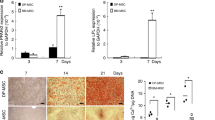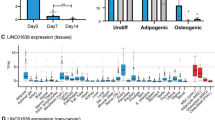Abstract
The BCL-6 co-repressor (BCOR) represses gene transcription by interacting with BCL-6 (Refs 1, 2). BCOR mutation is responsible for oculo-facio-cardio-dental (OFCD) syndrome, which is characterized by canine teeth with extremely long roots, congenital cataracts, craniofacial defects and congenital heart disease3,4,5. Here we show that BCOR mutation increased the osteo-dentinogenic potential of mesenchymal stem cells (MSCs) isolated from a patient with OFCD, providing a molecular explanation for abnormal root growth. AP-2α was identified as a repressive target of BCOR, and BCOR mutation resulted in abnormal activation of AP-2α. Gain- and loss-of-function assays suggest that AP-2α is a key factor that mediates the increased osteo-dentinogenic capacity of MSCs. Moreover, we found that BCOR maintained tissue homeostasis and gene silencing through epigenetic mechanisms. BCOR mutation increased histone H3K4 and H3K36 methylation in MSCs, thereby reactivating transcription of silenced target genes. By studying a rare human genetic disease, we have unravelled an epigenetic mechanism for control of human adult stem cell function.
This is a preview of subscription content, access via your institution
Access options
Subscribe to this journal
Receive 12 print issues and online access
$209.00 per year
only $17.42 per issue
Buy this article
- Purchase on Springer Link
- Instant access to full article PDF
Prices may be subject to local taxes which are calculated during checkout





Similar content being viewed by others
References
Huynh, K. D., Fischle, W., Verdin, E. & Bardwell, V. J. BCoR, a novel co-repressor involved in BCL-6 repression. Genes Dev. 14, 1810–1823 (2000).
Ghetu, A. F. et al. Structure of a BCOR co-repressor peptide in complex with the BCL-6 BTB domain dimer. Mol. Cell 29, 384–391 (2008).
Ng, D. et al. Oculofaciocardiodental and Lenz microphthalmia syndromes result from distinct classes of mutations in BCOR. Nature Genet. 36, 411–416 (2004).
Oberoi, S., Winder, A. E., Johnston, J., Vargervik, K. & Slavotinek, A. M. Case reports of oculofaciocardiodental syndrome with unusual dental findings. Am. J. Med. Genet. A. 136, 275–277 (2005).
Horn, D. et al. Novel mutations in BCOR in three patients with oculo-facio-cardio-dental syndrome, but none in Lenz microphthalmia syndrome. Eur. J. Hum. Genet. 13, 563–569 (2005).
Hedera, P. & Gorski, J. L. Oculo-facio-cardio-dental syndrome: skewed X chromosome inactivation in mother and daughter suggest X-linked dominant Inheritance. Am. J. Med. Genet. A. 123A, 261–266 (2003).
Schulze, B. R., Horn, D., Kobelt, A., Tariverdian, G. & Stellzig, A. Rare dental abnormalities seen in oculo-facio-cardio-dental (OFCD) syndrome: three new cases and review of nine patients. Am. J. Med. Genet. 82, 429–435 (1999).
Foster, B. L., Popowics, T. E., Fong, H. K. & Somerman, M. J. Advances in defining regulators of cementum development and periodontal regeneration. Curr. Top. Dev. Biol. 78, 47–126 (2007).
Kim, J. W. & Simmer, J. P. Hereditary dentin defects. J. Dent. Res. 86, 392–399 (2007).
MacDougall, M., Dong, J. & Acevedo, A. C. Molecular basis of human dentin diseases. Am. J. Med. Genet. A. 140, 2536–2546 (2006).
Sonoyama, W. et al. Mesenchymal stem cell-mediated functional tooth regeneration in swine. PLoS ONE 1, e79 (2006).
Ye, B. H. et al. Alterations of a zinc finger-encoding gene, BCL-6, in diffuse large-cell lymphoma. Science 262, 747–750 (1993).
Gearhart, M. D., Corcoran, C. M., Wamstad, J. A. & Bardwell, V. J. Polycomb group and SCF ubiquitin ligases are found in a novel BCOR complex that is recruited to BCL6 targets. Mol. Cell Biol. 26, 6880–6889 (2006).
Sanchez, C. et al. Proteomics analysis of Ring1B/Rnf2 interactors identifies a novel complex with the Fbxl10/Jhdm1B histone demethylase and the Bcl6 interacting corepressor. Mol. Cell Proteomics 6, 820–834 (2007).
Wamstad, J. A. & Bardwell, V. J. Characterization of Bcor expression in mouse development. Gene Expr. Patterns 7, 550–557 (2007).
Wamstad, J. A., Corcoran, C. M., Keating, A. M. & Bardwell, V. J. Role of the transcriptional corepressor Bcor in embryonic stem cell differentiation and early embryonic development. PLoS ONE 3, e2814 (2008).
Jahagirdar, B. N. & Verfaillie, C. M. Multipotent adult progenitor cell and stem cell plasticity. Stem Cell Rev. 1, 53–59 (2005).
Phinney, D. G. & Prockop, D. J. Concise review: mesenchymal stem/multipotent stromal cells: the state of transdifferentiation and modes of tissue repair—current views. Stem Cells 25, 2896–2902 (2007).
Scaffidi, P. & Misteli, T. Lamin A-dependent misregulation of adult stem cells associated with accelerated ageing. Nature Cell Biol. 10, 452–459 (2008).
Shi, S. et al. Bone formation by human postnatal bone marrow stromal stem cells is enhanced by telomerase expression. Nature Biotechnol. 20, 587–591 (2002).
Shi, S. & Wang, C. Y. Bone marrow stromal stem cells for repairing the skeleton. Biotechnol. Genet. Eng. Rev. 21, 133–143 (2004).
Seo, B. M. et al. Investigation of multipotent postnatal stem cells from human periodontal ligament. Lancet 364, 149–155 (2004).
Arthur, A., Rychkov, G., Shi, S., Koblar, S. A. & Gronthos, S. Adult human dental pulp stem cells differentiate towards functionally active neurons under appropriate environmental cues. Stem Cells (2008).
Chang, J. et al. Noncanonical Wnt-4 signaling enhances bone regeneration of mesenchymal stem cells in craniofacial defects through activation of p38 MAPK. J. Biol. Chem. 282, 30938–30948 (2007).
Butler, W. T., Brunn, J. C. & Qin, C. Dentin extracellular matrix (ECM) proteins: comparison to bone ECM and contribution to dynamics of dentinogenesis. Connect. Tissue Res. 44 Suppl 1, 171–178 (2003).
Scheller, E. L., Chang, J. & Wang, C. Y. Wnt/β-catenin inhibits dental pulp stem cell differentiation. J. Dent. Res. 87, 126–130 (2008).
Schorle, H., Meier, P., Buchert, M., Jaenisch, R. & Mitchell, P. J. Transcription factor AP-2 essential for cranial closure and craniofacial development. Nature 381, 235–238 (1996).
Brewer, S., Feng, W., Huang, J., Sullivan, S. & Williams, T. Wnt1-Cre-mediated deletion of AP-2α causes multiple neural crest-related defects. Dev. Biol. 267, 135–152 (2004).
Frescas, D., Guardavaccaro, D., Bassermann, F., Koyama-Nasu, R. & Pagano, M. JHDM1B/FBXL10 is a nucleolar protein that represses transcription of ribosomal RNA genes. Nature 450, 309–313 (2007).
Tsukada, Y. et al. Histone demethylation by a family of JmjC domain-containing proteins. Nature 439, 811–816 (2006).
Shi, Y. & Whetstine, J. R. Dynamic regulation of histone lysine methylation by demethylases. Mol. Cell 25, 1–14 (2007).
Klose, R. J., Kallin, E. M. & Zhang, Y. JmjC-domain-containing proteins and histone demethylation. Nature Rev. Genet. 7, 715–727 (2006).
He, J., Kallin, E. M., Tsukada, Y. & Zhang, Y. The H3K36 demethylase Jhdm1b/Kdm2b regulates cell proliferation and senescence through p15(Ink4b). Nature Struct. Mol. Biol. 15, 1169–1175 (2008).
West-Mays, J. A., Coyle, B. M., Piatigorsky, J., Papagiotas, S. & Libby, D. Ectopic expression of AP-2α transcription factor in the lens disrupts fiber cell differentiation. Dev. Biol. 245, 13–27 (2002).
Park, B.K. et al. NFκB in breast cancer cells promotes osteolytic bone metastasis by inducing osteoclastogenesis via GMCSF. Nature Med. 13, 62–69 (2007).
Acknowledgements
This work was supported by the National Institute of Dental and Craniofacial Research Grants (R01DE1016513 and R01DE017684) to C.Y.W. (R21DE017632) and S.S., and the Shapiro Family Charitable Foundation. We thank Vivian Bardwell for reagents.
Author information
Authors and Affiliations
Contributions
Z.F., T.Y. and J.Y. performed experiments and prepared figures; J.S.L. prepared samples and directed the experiments; G.F. and S.W. assisted with the genetic analysis; S.S. and C.Y.W. designed the experiments and analysed the data; C.Y.W. wrote the manuscript.
Corresponding author
Ethics declarations
Competing interests
The authors declare no competing financial interests.
Supplementary information
Supplementary Information
Supplementary Information (PDF 736 kb)
Supplementary Information
Supplementary Table 1 (XLS 28 kb)
Rights and permissions
About this article
Cite this article
Fan, Z., Yamaza, T., Lee, J. et al. BCOR regulates mesenchymal stem cell function by epigenetic mechanisms. Nat Cell Biol 11, 1002–1009 (2009). https://doi.org/10.1038/ncb1913
Received:
Accepted:
Published:
Issue Date:
DOI: https://doi.org/10.1038/ncb1913
This article is cited by
-
Early ependymal tumor with MN1-BEND2 fusion: a mostly cerebral tumor of female children with a good prognosis that is distinct from classical astroblastoma
Journal of Neuro-Oncology (2023)
-
MicroRNA-196a-5p overexpression in Wharton’s jelly umbilical cord stem cells promotes their osteogenic differentiation and new bone formation in bone defects in the rat calvarium
Cell and Tissue Research (2022)
-
Histone modifications centric-regulation in osteogenic differentiation
Cell Death Discovery (2021)
-
A positive feedback loop between Periostin and TGFβ1 induces and maintains the stemness of hepatocellular carcinoma cells via AP-2α activation
Journal of Experimental & Clinical Cancer Research (2021)
-
Control of mesenchymal stem cell biology by histone modifications
Cell & Bioscience (2020)



